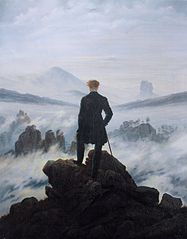
The sublime is derived from the 18th century philosophy of Immanuel Kant and Edmund Burke (for example, see Hirshberg 1994). As Coyne describes it (1999, 61-2), the sublime consists of:
… awe and admiration at the various spectacles of nature that raise the soul above the vulgar and the commonplace, arousing emotions akin to fear rather than merely joy … manifested in the contemplation of raging cataracts, perilous views from mountaintops, the forces of nature, expanses of uninhabitable landscapes, the infinity of space and time, but also breathtaking artificial structures and powerful machinery … the concept of the romantic sublime provided a substitute for Christian cosmology displaced by the growth of science … The romantic quest frequently discovered the sublime in the technological.
Having written and spoken about the fetishism of digital archaeology in the past (e.g. Huggett 2004), the concept of the sublime speaks to me not least because it pushes the concept of technological fetishism further and makes a host of other connections at the same time. For instance, an obvious link is with William Gibson’s classic Neuromancer and cyberspace – the technological sublime incorporating transcendence, enlightenment, empowerment etc., or, more recently, Elon Musk’s claim that we (probably) live in a computer simulation (e.g. Griffin 2016).
Considering the digital sublime underlines the close relationship between digital technology and faith/belief, if not religion. This doesn’t have to be on the transhuman level of Ray Kurzweil’s Singularity, the event horizon of which is the point at which the distinction between biological and mechanical, physical and virtual reality disappears and we become ‘spiritual machines’ (Kurzweil 2005). Nor does it have to be in the present (or near-future). David Nye (1994), for example, has discussed the impact of a range of case studies he identifies with the technological sublime, from the development of the railroad, the construction of the Brooklyn bridge and the Hoover Dam, the development of the factory, skyscrapers, the atomic bomb, and the moon landing. In much the same way, Neil Postman (1997) described how in the nineteenth and first half of the twentieth century we remade the information world through technology:
… unleashing a meteoric shower of facts, with telegraphy, photography, the rotary press, the telephone, the typewriter, the phonograph, the transatlantic cable, radio waves, movies, the x-ray, the computer, and the stethoscope—not to mention the penny press, the modern magazine, the advertising agency, and modern bureaucracy.
As the sublime invokes both awe and fear, uncertainty and insecurity, so the exponential development of technologies can seem to both empower and disenfranchise. When our approach to technology is encapsulated by the sublime, technology assumes mythical status and becomes unquestioned and unquestionable, disappearing into the infrastructures that control us and govern our world. Consequently the sublime reinforces the progressive narrative that typically surrounds technological discourse and requires what Julia Flanders (2009, 12) in the context of digital humanities has described as a ‘productive unease’. This she suggests:
… registers as a sense of friction between familiar mental habits and the affordances of the tool, but it is ideally a provocative friction, an irritation that prompts further thought and engagement.
She goes on to say that where that sense of friction is absent, humanities computing, in any meaningful sense, is also absent (Flanders 2009, 12).
That raises an interesting question for archaeology: if the enchantment of the sublime subsumes critique, does Digital Archaeology cease to exist? If Digital Archaeology does not provide that sense of productive unease, that provocative friction, then is there any value to it? In the face of such existential doubt, it seems appropriate to fall back to the words of John Perry Barlow, a former lyricist with the Grateful Dead, responding to some over-euphoric proponents of virtual reality at a SIGGRAPH conference in 1990:
… bullshit is the grease for the skids upon which we ride into the future …
(quoted in Woolley 1992, 12). So for me, a key role for Digital Archaeology has to be to deal with the bullshit associated with the archaeological digital sublime …
References
Coyne, R. 1999 Technoromanticism: digital narrative, holism, and the romance of the real (Cambridge, Mass; Massachusetts Institute of Technology).
Flanders, J. 2009 ‘The Productive Unease of 21st-century Digital Scholarship’, Digital Humanities Quarterly 3 (3). http://www.digitalhumanities.org/dhq/vol/3/3/000055/000055.html
Griffin, A. 2016 ‘Elon Musk: The chance we are not living in a computer simulation is “one in billions”’, Independent (02/06/2016) https://www.independent.co.uk/life-style/gadgets-and-tech/news/elon-musk-ai-artificial-intelligence-computer-simulation-gaming-virtual-reality-a7060941.html
Hirshberg, G. 1994 ‘Kant, Burke and the Sublime’, Philosophy Now 11 https://philosophynow.org/issues/11/Burke_Kant_and_the_Sublime
Huggett, J. 2004 ‘Archaeology and the new technological fetishism’, Archeologia e Calcolatori 15, 81-92. http://www.archcalc.cnr.it//indice/PDF15/05_Hugget.pdf
Kurzweil, R. 2005 The Singularity is Near: When Humans Transcend Biology. Viking Penguin: New York.
Nye, D. 1994 American technological sublime. Cambridge (Mass): The MIT Press.
Postman, N. 1997 Science and the Story that We Need, First Things January 1997. https://www.firstthings.com/article/1997/01/science-and-the-story-that-we-need
Woolley, B. 1992 Virtual Worlds: A Journey in Hyper and Hyperreality (Penguin Books).


